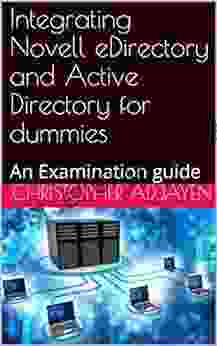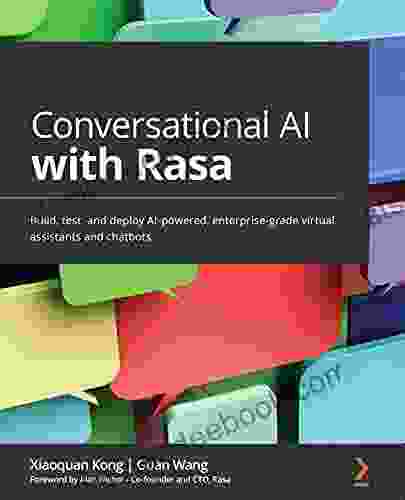Integrating Novell eDirectory and Active Directory for Dummies

Novell eDirectory and Active Directory (AD) are two of the most popular directory services used in enterprise networks today. eDirectory is a proprietary LDAP-based directory service developed by Novell, while AD is a Microsoft-proprietary LDAP-based directory service.
Integrating eDirectory and AD can provide a number of benefits for organizations, including:
- Centralized user management: Manage users and groups from a single console, regardless of which directory service they are stored in.
- Single sign-on (SSO): Allow users to access applications and resources using a single set of credentials across both eDirectory and AD.
- Improved security: By integrating eDirectory and AD, organizations can create a more secure environment by centralizing user authentication and authorization.
Before you begin integrating eDirectory and AD, it is important to carefully plan your integration. This includes:
4.7 out of 5
| Language | : | English |
| File size | : | 1337 KB |
| Text-to-Speech | : | Enabled |
| Screen Reader | : | Supported |
| Enhanced typesetting | : | Enabled |
| Print length | : | 39 pages |
| Lending | : | Enabled |
- Identifying the scope of your integration: Determine which users and groups need to be integrated, and which applications and resources will be accessed using SSO.
- Choosing a synchronization method: There are a number of different methods for synchronizing eDirectory and AD, including:
- Full synchronization: This method replicates all changes between eDirectory and AD.
- Incremental synchronization: This method only replicates changes that have occurred since the last synchronization.
- Configuring your synchronization schedule: Determine how often you want to synchronize your directories.
- Testing your integration: Once you have configured your integration, it is important to test it thoroughly to ensure that it is working as expected.
Once you have planned your integration, you can begin configuring it. The specific steps involved will vary depending on the synchronization method you choose. However, the following general steps are common to all synchronization methods:
- Install the necessary software: You will need to install the appropriate software on both your eDirectory and AD servers.
- Configure your synchronization settings: This includes specifying the scope of your integration, the synchronization method, and the synchronization schedule.
- Create a synchronization account: This account will be used to perform the synchronization between eDirectory and AD.
- Start the synchronization process: Once you have configured your synchronization settings, you can start the synchronization process.
If you encounter any problems with your integration, there are a number of troubleshooting steps you can take:
- Check the synchronization logs: The synchronization logs can provide you with information about any errors that have occurred during the synchronization process.
- Check the event logs: The event logs can also provide you with information about any errors that have occurred.
- Contact Novell or Microsoft support: If you are unable to resolve the problem on your own, you can contact Novell or Microsoft support for assistance.
There are a number of best practices that you can follow to ensure that your integration is successful. These include:
- Use a dedicated synchronization server: This will help to ensure that the synchronization process is not impacted by other server processes.
- Schedule regular synchronization: This will help to ensure that your directories are always up-to-date.
- Monitor your synchronization process: This will help you to identify and resolve any problems that may occur.
- Implement SSO: SSO can provide a number of benefits for users, including improved convenience and security.
Integrating eDirectory and AD can provide a number of benefits for organizations. By carefully planning, configuring, and troubleshooting your integration, you can ensure that it is successful and that you are able to reap the benefits of a unified directory service.
4.7 out of 5
| Language | : | English |
| File size | : | 1337 KB |
| Text-to-Speech | : | Enabled |
| Screen Reader | : | Supported |
| Enhanced typesetting | : | Enabled |
| Print length | : | 39 pages |
| Lending | : | Enabled |
Do you want to contribute by writing guest posts on this blog?
Please contact us and send us a resume of previous articles that you have written.
 Book
Book Chapter
Chapter Story
Story Genre
Genre Reader
Reader Paperback
Paperback E-book
E-book Magazine
Magazine Bookmark
Bookmark Shelf
Shelf Bibliography
Bibliography Preface
Preface Synopsis
Synopsis Footnote
Footnote Scroll
Scroll Codex
Codex Bestseller
Bestseller Library card
Library card Narrative
Narrative Autobiography
Autobiography Memoir
Memoir Encyclopedia
Encyclopedia Dictionary
Dictionary Thesaurus
Thesaurus Character
Character Card Catalog
Card Catalog Borrowing
Borrowing Periodicals
Periodicals Study
Study Scholarly
Scholarly Reserve
Reserve Academic
Academic Reading Room
Reading Room Rare Books
Rare Books Thesis
Thesis Storytelling
Storytelling Awards
Awards Reading List
Reading List Book Club
Book Club Textbooks
Textbooks Jamie Veronica
Jamie Veronica Brian Surber
Brian Surber William J Vanden Heuvel
William J Vanden Heuvel Greg Malone
Greg Malone Carole Brewer
Carole Brewer Monica Gunning
Monica Gunning Debbie Shore
Debbie Shore Roman Pichler
Roman Pichler Louis Romano
Louis Romano David Schiller
David Schiller Alison J Reid
Alison J Reid Curtis J Austin
Curtis J Austin Irene Flores
Irene Flores Milton P Dentch
Milton P Dentch Enes Bilgin
Enes Bilgin George Victory
George Victory Mikael Shainkman
Mikael Shainkman Craig Wilson
Craig Wilson Elizabeth Bromke
Elizabeth Bromke Steve Lodder
Steve Lodder
Light bulbAdvertise smarter! Our strategic ad space ensures maximum exposure. Reserve your spot today!

 Hudson HayesSeduced by the Horizon: An Enchanting Tale of Love, Art, and the Unattainable
Hudson HayesSeduced by the Horizon: An Enchanting Tale of Love, Art, and the Unattainable
 Theodore MitchellFrom Year in Greece: An Unforgettable Odyssey Through History, Culture, and...
Theodore MitchellFrom Year in Greece: An Unforgettable Odyssey Through History, Culture, and...
 George R.R. MartinUnveiling the Elegance of Melody Chords: A Journey Through Allan Holdsworth's...
George R.R. MartinUnveiling the Elegance of Melody Chords: A Journey Through Allan Holdsworth's... Colt SimmonsFollow ·13.4k
Colt SimmonsFollow ·13.4k Colin FosterFollow ·10.1k
Colin FosterFollow ·10.1k Edison MitchellFollow ·3.7k
Edison MitchellFollow ·3.7k Herman MitchellFollow ·14.2k
Herman MitchellFollow ·14.2k Henry David ThoreauFollow ·17.1k
Henry David ThoreauFollow ·17.1k Vladimir NabokovFollow ·18.1k
Vladimir NabokovFollow ·18.1k Clark BellFollow ·14.6k
Clark BellFollow ·14.6k Hunter MitchellFollow ·8.8k
Hunter MitchellFollow ·8.8k

 Brian Bell
Brian BellClassic Festival Solos Bassoon Volume Piano...
The Classic Festival Solos Bassoon Volume...

 Aubrey Blair
Aubrey BlairUnveiling the Courage: Insurgent Women Female Combatants...
In the face of armed...

 Jan Mitchell
Jan MitchellFor The Liberty Of Texas: The Lone Star State's Fight for...
The Republic of Texas was a sovereign state...

 Edgar Allan Poe
Edgar Allan PoeVisible, Explainable, Trustworthy, and Transparent...
What is VET2...
4.7 out of 5
| Language | : | English |
| File size | : | 1337 KB |
| Text-to-Speech | : | Enabled |
| Screen Reader | : | Supported |
| Enhanced typesetting | : | Enabled |
| Print length | : | 39 pages |
| Lending | : | Enabled |










